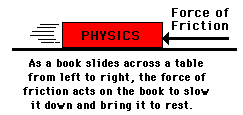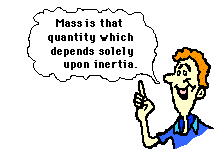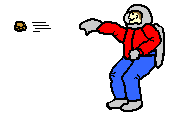Newton's Laws - Lesson 1 - Newton's First Law of Motion
Inertia: the resistance an object has to a change in its state of motion.
Newton's conception of inertia stood in direct opposition to more popular conceptions about motion. The dominant thought prior to Newton's day was that it was the natural tendency of objects to come to a rest position. Moving objects, so it was believed, would eventually stop moving; a force was necessary to keep an object moving. But if left to itself, a moving object would eventually come to rest and an object at rest would stay at rest; thus, the idea that dominated people's thinking for nearly 2000 years prior to Newton was that it was the natural tendency of all objects to assume a rest position.
Galileo and the Concept of Inertia
Galileo, a premier scientist in the seventeenth century, developed the concept of inertia. Galileo reasoned that moving objects eventually stop because of a force called friction. In experiments using a pair of inclined planes facing each other, Galileo observed that a ball would roll down one plane and up the opposite plane to approximately the same height. If smoother planes were used, the ball would roll up the opposite plane even closer to the original height. Galileo reasoned that any difference between initial and final heights was due to the presence of friction. Galileo postulated that if friction could be entirely eliminated, then the ball would reach exactly the same height.
Galileo further observed that regardless of the angle at which the planes were oriented, the final height was almost always equal to the initial height. If the slope of the opposite incline were reduced, then the ball would roll a further distance in order to reach that original height.

Galileo's reasoning continued - if the opposite incline were elevated at nearly a 0-degree angle, then the ball would roll almost forever in an effort to reach the original height. And if the opposing incline was not even inclined at all (that is, if it were oriented along the horizontal), then ... an object in motion would continue in motion... .

Forces Don't Keep Objects Moving
 Isaac Newton built on Galileo's thoughts about motion. Newton's first law of motion declares that a force is not needed to keep an object in motion. Slide a book across a table and watch it slide to a rest position. The book in motion on the table top does not come to a rest position because of the absence of a force; rather it is the presence of a force - that force being the force of friction - that brings the book to a rest position. In the absence of a force of friction, the book would continue in motion with the same speed and direction - forever! (Or at least to the end of the table top.) A force is not required to keep a moving book in motion. In actuality, it is a force that brings the book to rest.
Isaac Newton built on Galileo's thoughts about motion. Newton's first law of motion declares that a force is not needed to keep an object in motion. Slide a book across a table and watch it slide to a rest position. The book in motion on the table top does not come to a rest position because of the absence of a force; rather it is the presence of a force - that force being the force of friction - that brings the book to a rest position. In the absence of a force of friction, the book would continue in motion with the same speed and direction - forever! (Or at least to the end of the table top.) A force is not required to keep a moving book in motion. In actuality, it is a force that brings the book to rest.
Mass as a Measure of the Amount of Inertia
 All objects resist changes in their state of motion. All objects have this tendency - they have inertia. But do some objects have more of a tendency to resist changes than others? Absolutely yes! The tendency of an object to resist changes in its state of motion varies with mass. Mass is that quantity that is solely dependent upon the inertia of an object. The more inertia that an object has, the more mass that it has. A more massive object has a greater tendency to resist changes in its state of motion.
All objects resist changes in their state of motion. All objects have this tendency - they have inertia. But do some objects have more of a tendency to resist changes than others? Absolutely yes! The tendency of an object to resist changes in its state of motion varies with mass. Mass is that quantity that is solely dependent upon the inertia of an object. The more inertia that an object has, the more mass that it has. A more massive object has a greater tendency to resist changes in its state of motion.
Suppose that there are two seemingly identical bricks at rest on the physics lecture table. Yet one brick consists of mortar and the other brick consists of Styrofoam. Without lifting the bricks, how could you tell which brick was the Styrofoam brick? You could give the bricks an identical push in an effort to change their state of motion. The brick that offers the least resistance is the brick with the least inertia - and therefore the brick with the least mass (i.e., the Styrofoam brick).
 A common physics demonstration relies on this principle that the more massive the object, the more that object resist changes in its state of motion. The demonstration goes as follows: several massive books are placed upon a teacher's head. A wooden board is placed on top of the books and a hammer is used to drive a nail into the board. Due to the large mass of the books, the force of the hammer is sufficiently resisted (inertia). This is demonstrated by the fact that the teacher does not feel the hammer blow. (Of course, this story may explain many of the observations that you previously have made concerning your "weird physics teacher.") A common variation of this demonstration involves breaking a brick over the teacher's hand using the swift blow of a hammer. The massive bricks resist the force and the hand is not hurt. (CAUTION: do not try these demonstrations at home.)
A common physics demonstration relies on this principle that the more massive the object, the more that object resist changes in its state of motion. The demonstration goes as follows: several massive books are placed upon a teacher's head. A wooden board is placed on top of the books and a hammer is used to drive a nail into the board. Due to the large mass of the books, the force of the hammer is sufficiently resisted (inertia). This is demonstrated by the fact that the teacher does not feel the hammer blow. (Of course, this story may explain many of the observations that you previously have made concerning your "weird physics teacher.") A common variation of this demonstration involves breaking a brick over the teacher's hand using the swift blow of a hammer. The massive bricks resist the force and the hand is not hurt. (CAUTION: do not try these demonstrations at home.)Watch It!
A physics instructor explains the property of inertia using a phun physics demonstration.
Check Your Understanding
 1. Imagine a place in the cosmos far from all gravitational and frictional influences. Suppose that you visit that place (just suppose) and throw a rock. The rock will
1. Imagine a place in the cosmos far from all gravitational and frictional influences. Suppose that you visit that place (just suppose) and throw a rock. The rock willa. gradually stop.
b. continue in motion in the same direction at constant speed.
2. A 2-kg object is moving horizontally with a speed of 4 m/s. How much net force is required to keep the object moving at this speed and in this direction?

3. Mac and Tosh are arguing in the cafeteria. Mac says that if he flings the Jell-O with a greater speed it will have a greater inertia. Tosh argues that inertia does not depend upon speed, but rather upon mass. Who do you agree with? Explain why.
4. Supposing you were in space in a weightless environment, would it require a force to set an object in motion?
5. Fred spends most Sunday afternoons at rest on the sofa, watching pro football games and consuming large quantities of food. What affect (if any) does this practice have upon his inertia? Explain.
6. Ben Tooclose is being chased through the woods by a bull moose that he was attempting to photograph. The enormous mass of the bull moose is extremely intimidating. Yet, if Ben makes a zigzag pattern through the woods, he will be able to use the large mass of the moose to his own advantage. Explain this in terms of inertia and Newton's first law of motion.
7. Two bricks are resting on edge of the lab table. Shirley Sheshort stands on her toes and spots the two bricks. She acquires an intense desire to know which of the two bricks are most massive. Since Shirley is vertically challenged, she is unable to reach high enough and lift the bricks; she can however reach high enough to give the bricks a push. Discuss how the process of pushing the bricks will allow Shirley to determine which of the two bricks is most massive. What difference will Shirley observe and how can this observation lead to the necessary conclusion?






